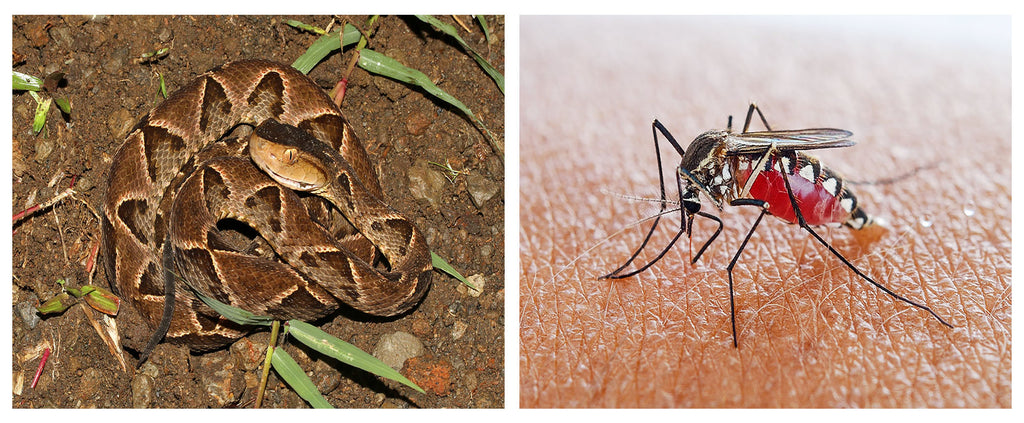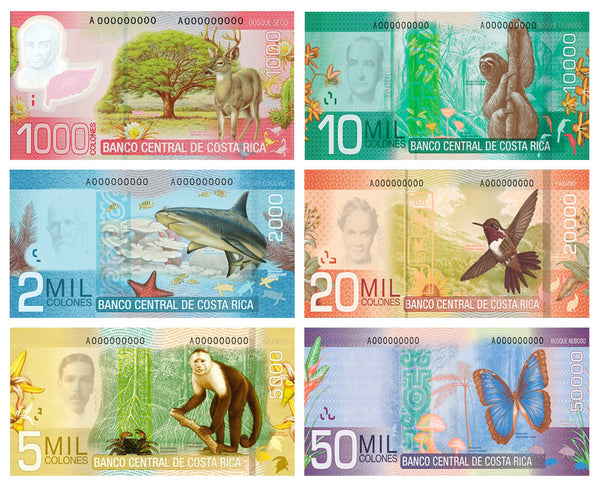Costa Rica Information
Costa Rica is a small Central American country with a population of 5 million people and lies between Nicaragua to the north, Panama to the south, the Caribbean Sea to the east, and Pacific Ocean to the west. It is known for its progressive environmental policies, being the only country to meet all five United Nations Development Program criteria established to measure environmental sustainability. Costa Rica was twice ranked the best performing country in the New Economics Foundation's (NEF) Happy Planet Index, which measures environmental sustainability, and was identified by the NEF as the greenest country in the world in 2009.
Costa Rica is home to over 500,000 species of plants, insects, amphibians, reptiles, birds, and mammals and is blessed with gorgeous beaches, tropical rainforests, misty cloud forests, active volcanoes, rolling hills of vibrant farmland, sparkling lakes, and an endless supply of colorful rivers and jaw-dropping waterfalls.
The climate of Costa Rica is tropical year round, however, the country has many micro-climates depending on elevation, rainfall, topography, and geography of each particular region. Costa Rica's seasons are defined by how much rain falls during a particular period and the year can be split into two periods: the dry season, known to residents as summer, and the rainy season, known as winter. Summer, or the dry season, lasts from mid-December through the end of April, while winter, or the rainy season, extends from May to mid-December.
Costa Ricans refer to themselves as Ticos in place of the more formal costarricenses and Spanish is the country's official language. English is generally only spoken in tourist destinations. Costa Rica is known for the saying, "pura vida" which translates to "pure life," and is a way of living life with a relaxed, positive attitude. Ticos use the phrase to say, "hello" and "goodbye," answer the questions, "How are you?" or "How's it going?" or to simply say, "All good," or "life is good."

Costa Rica possesses the highest density of biodiversity of any country worldwide and contains four percent of species estimated to exist on the planet. Over 500,000 species thrive in Costa Rica, and hundreds of those exist nowhere else on earth. While many creatures are cute and harmless, Costa Rica also hosts more than its share of dangerous, deadly animals, and below is information about Costa Rica's own Big Five predators. This isn't meant to alarm you or stop you from visiting Costa Rica, but rather make you aware of the presence of these creatures, and to provide you with precautions you can take - and that ColorTexturePhotoTours does take - to avoid them.
With 130 species of snakes, 22 of which are venomous, it is estimated that Costa Rica has at least two deadly snakes per hectare. By far, the most dangerous is the Fer-de-Lance (Bothrops asper), a pit viper that can reach up to six feet in length. This aggressive ambush predator can open its jaws up to 180 degrees before striking perceived threats with fangs nearly an inch long and its venom spreads through cells and blood vessels, causes swelling and blisters, destroys tissue, and bites can lead to infection, amputation, and death. Nearly 600 snake bites are recorded each year in Costa Rica, most from the Fer-de-Lance, but due to anti-venom produced by the Clodomiro Picado Institute, very few bites are fatal.
Here are some safety tips for avoiding snakes: Always watch where you step and use caution when exploring. Avoid passing through high grass, heavy brush, and hollow logs without first investigating thoroughly. Do not grab vines or branches, stick your hands in rock crevices, or pick flowers or other plants without first investigating the area for snakes. Do not travel on unlit paths at night without a flashlight, as most venomous snakes are active at dusk and night. Wear proper foot gear - hiking boots or heavy walking shoes - and do not go barefoot or wear sandals when exploring in high grass or brush.
They are mostly annoying and their bites can cause severe itching, but some mosquitos in Costa Rica also carry Dengue Fever and Malaria. While vaccinations are not required to visit Costa Rica, ColorTexturePhotoTours strongly encourages you to consult your doctor regarding tropical diseases, vaccinations, and medications. Covering up, and using a natural, non-DEET insect repellent is highly recommended.

Due to its size and powerful bite, jaguars are mistakenly thought to be Costa Rica's most dangerous cat, but of the cat species large enough to prey on humans, jaguars are the least likely to attack. On the other hand, cougars (Puma concolor), Costa Rica’s second-largest cat species, have been known to be aggressive towards humans in their territories. While a cougar is certainly powerful enough to wound or even kill a human, attacks are very rare and there are no reports of deaths in recent years.
Of the 20,000 species of spiders in Costa Rica, the Brazilian Wandering Spider (Phoneutria fera), also known as the banana spider, is recognized as the world’s most toxic spider. Because of a powerful neurotoxin, a bite from this spider causes a loss of muscle control, and if left untreated, can eventually kill through paralysis and asphyxiation. Brazilian Wandering Spiders are aggressive and common in the jungles and banana plantations in Costa Rica, but most bites occur from spiders hiding in shoes. Remember to always shake out your shoes before putting them on.

Since 2013, five people have lost their lives to the American Crocodile (Crocodylus acutus) in Costa Rica, and in some areas, the expansion of tourist businesses and residences has put crocodiles in a closer proximity to humans than ever before, while other parts of Costa Rica are now overpopulated with crocodiles fleeing their former territories. Have no fear, ColorTexturePhotoTours does not venture into crocodile territory.

US dollars are accepted in most locations but it's also good to have colones - the currency of Costa Rica. Cash machines (ATMs) are plentiful in Costa Rica but due to skimming devices that are placed on random ATMs to steal debit and credit card data, it is advised to only use ATMs at banks. Most ATMs give you a choice of US dollars or colones.

Credit Cards
Credit cards are welcomed throughout Costa Rica, and when you use your card, you will usually be charged in colones. It's best to use a credit card that does not charge international fees, as those fees can quickly add up.
Currency Exchange
To exchange currency, the best rates are given at Costa Rica banks and you will need to provide your passport. You can also exchange currency at airports but rates are much lower than at banks. Current exchange rate is approximately 600 colones per $1 US dollar.
Driving
Anyone with a current US driver's license can legally drive in Costa Rica but beware, driving in Costa Rica can be an adventure! Outside the capital city of San Jose, there are no signs with street names, and nationwide, many roads are uneven, unpaved, and littered with potholes and speed bumps. Costa Rica is mountainous, roads are narrow and curvy, and Ticos drive fast and aggressively and often pass slower-moving vehicles at dangerous times. Driving at night increases risk as roads are poorly lit (not at all in many areas), and because there are very few sidewalks, Ticos walk and ride bicycles on the roads. Always drive defensively and be prepared for anything!
Electricity
Electricity in Costa Rica is the same as the United States - 110 Volts - but it's always good to have 3-prong-to-2-prong converters, as some outlets are only 2-prong.

When you leave Costa Rica, you are required to pay an exit tax at the airport - currently $29.00 - and you can pay with US dollars, colones, or a credit card. Some airlines include the exit tax in your ticket price, and if you are unsure, you can ask an airline representative at the airport.
Food & Drink
Costa Rican cuisine is a blend of Native American, Spanish, African, and many other cultures. A typical meal is the casado, which consists of rice, beans, meat or fish, fried plantains, and a cabbage, carrot, and tomato salad. Gallo Pinto is a traditional dish and staple of Costa Rica. It consists of black beans and white rice cooked together and is served with meals at all times of the day.
Arroz is a fried rice dish often served with chicken or shrimp. Ceviche is a common and delicious appetizer made with raw fish that's been marinated in lime juice with cilantro and onions. The fish is "cooked" by the acidity of the lime juice then served with tortilla chips. Sea bass, or corvina, is Costa Rica's fish of choice, but dorado, swordfish, and many others are available at coastal resorts.
Ultra-fresh seafood is more readily available near the coasts, but shrimp and lobster are offered throughout most of the country. Pork and chicken are often roasted over coffee wood for a savory, smoky flavor, and steaks can be found at many restaurants. Vegetables are commonly served in soups, and fresh fruit includes apples, avocados, bananas, cantaloupe, guavas, lemons, limes, mangoes, oranges, papayas, passion fruit, pineapples, and watermelon. Plantains, or plántanos, are a quintessential Tico favorite and are sweet and delicious when slow-cooked and become a crunchy snack similar to potato chips when sliced thin and deep-fried.
Coffee is the national drink of Costa Rica and Ticos routinely drink coffee and eat sweet bread in the afternoon. Refrescos, made of blended fruit and ice, are very popular refreshments available at most corner stores and restaurants. Beer is a common drink among Ticos and Imperial is the national favorite. Imperial makes light, crisp, lager-style beers, perfect thirst-quenchers for the balmy, tropical climate. Wine is not very popular and is usually imported and expensive. Liquors are plentiful and the workingman's drink is guaro, a clear sugarcane-based spirit that doesn't always appeal to visitors.

Health
Malaria and Dengue Fever exist in Costa Rica, although cases of tourists becoming infected with these and other tropical diseases are rarely seen. ColorTexturePhotoTours does not take clients to areas with high-infestation of tropical diseases but it's best to consult with your doctor when making decisions about whether or not to receive vaccinations or take medication. Also, sometimes a change in diet can cause an upset stomach or diarrhea. If the problem persists for more than 24 hours, over-the-counter medications like Imodium-D or Pepto-Bismol usually control the problem. If diarrhea is accompanied by fever or severe nausea, it's best to see a doctor.
Missing Luggage
If your luggage does not arrive in Costa Rica on your flight, you will have to fill out a claim form with the airline, and transportation of your luggage to the location where you will be, must be arranged directly between you and the airline. If the airline agrees to pay ColorTexturePhotoTours to retrieve your luggage, we will be happy to so do, but you will first have to sign a statement authorizing ColorTexturePhotoTours to retrieve your luggage when it arrives in Costa Rica. It is also necessary for ColorTexturePhotoTours to have a copy of your passport in order to retrieve missing luggage.
Passports
Many hotels have safes in their rooms and we suggest that you use them. We also suggest that you bring a photocopy of your passport to help reduce the risk of losing or misplacing your original. If your passport is lost or stolen, you will have to contact local police and go to the US Embassy in San Jose to have a new passport issued. Information for the US Embassy is listed below.
Phone Calls
You can call anywhere in the world from all public or private phones in Costa Rica. 800 numbers will be charged as long-distance calls from Costa Rica. We suggest clients use the smart phone app WhatsApp for texting and calling. WhatsApp is free anywhere in the world when used on a Wi-Fi network. For more information click here.

Safety & Theft
Costa Rica has always been safe compared to other Central American countries, but crime associated with illegal drugs has grown, and Costa Rica is dealing with an increasing problem of drug abuse. Since most drug addicts don’t hold regular jobs, there has been an increase in crime against tourists. The vast majority of these crimes are non-violent theft from parked cars, belongings left on the beach, and luggage left unattended on buses or in hotel rooms while the occupants are out. For prevention, use common sense, lock your doors, and use the safe in your hotel room. Don’t flash wads of cash. Don't leave valuables in vehicles. Don’t bring your jewelry. Don't drink alcohol in excess. Don't venture out alone after dark. If you follow this advice, your trip to Costa Rica will be safe and enjoyable.
Sales Tax
Sales tax in Costa Rica is currently 13% and is added to all purchases.
Sunburn
Because of its close proximity to the equator, Costa Rica receives plenty of sunshine and sunburns happen quickly. Protective clothing, a hat, and sunscreen are advised.
Tipping
Tipping is not required in restaurants or for taxis in Costa Rica, but airport personnel that help with your luggage, bartenders, bellhops and cleaning staff, drivers, guides, and instructors should all be tipped. Guidelines are as follows: Airport Personnel - $1 per bag. Bartenders - $1 per drink. Bellhops - $1 per bag. Cleaning Staff - $2 to $3 per night. Drivers - $5 to $10 per day. Guides and instructors - $25 to $30 per person per day.
Traveler's Cheques
Traveler's cheques are widely accepted in hotels throughout Costa Rica and $20.00 denominations are best. You will be asked to write your passport number on the back of traveler's cheques and change will be given in colones.
Travel Insurance
Most people believe travel insurance is a waste of money, but for a photography tour, travel insurance can be a lifesaver. Travel insurance not only covers every day inconveniences like lost luggage or a misplaced or stolen passport, but if you have to cancel your photo tour because a connecting flight was delayed or canceled or a family member suddenly becomes ill, you have the ability to recover all the money you paid. Also, if you are seriously injured on a photography tour and need emergency medical attention and/or evacuation, those costs are covered. For all these reasons, ColorTexturePhotoTours strongly recommends that you purchase travel insurance.
US Embassy Info
Consular officers monitor the general welfare of American citizens in Costa Rica, Monday - Friday from 8:00am - 4:30pm. In case of an emergency, call (506) 2519-2000. General telephone: (506) 2519-2000 or (506) 2220-3127. From the United States: 011-506-2519-2000 or 011-506-2220-3127. Consular Fax: (506) 2220-2455. Consular Fax from the United States: 011-506-2519-2455. Consular Email Address: ACSSanJose@state.gov. 
